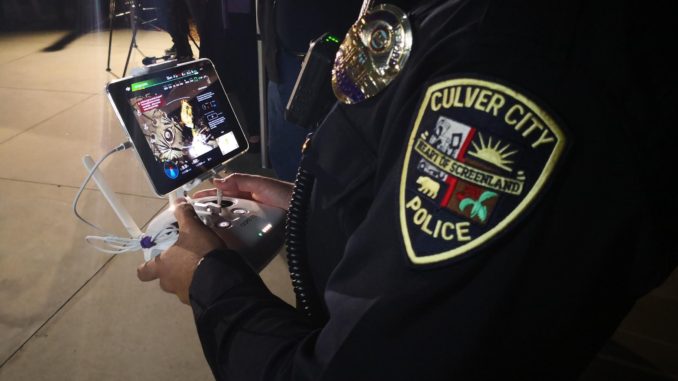
The Culver City Council meeting of Jan 28, 2019 was preceded by a police presentation in the courtyard; one of the unmanned arial vehicles – drones – started at 6 pm, drawing a small crowd of onlookers and a few protestors. The drone that was used in the display, the Phantom 4 Pro, is the mid-sized machine now possessed by the department, and it took a few short flights above the Fire Department Vehicle that was the base monitoring station, growing quieter as it rose higher into the air, flashing small green and red lights to stay visible, it was an odd presence in the City Hall courtyard. The other models, Matrice and Spark were on display on a table so that the public could examine them closely. Captain Jason Sims was on hand to answer questions, as were a number of other members of the force.
At 7 pm, when the meeting began in the chambers, the seats were filled with people who had concerns on the issue, and more than 20 speaker cards were filed with the city clerk. Several of the speakers were people who had attended both previous community outreach meetings offered by the police, and some others were people representing organizations outside the city.
When Sims spoke to make the official staff report, his presentation of the policy regarding the use of the drones came with the statement that he had met with “a community representative from the Culver City Action Network, Gerald Weiner, and we were able to have a very useful dialogue, and made some changes to the policy.”
Using a double list with one side in red and the other in black to display Policy 604.8, Sims pointed out that items on drone use for crowd control, event security and search warrant support had each been eliminated. He also cited the body-camera policy used by the department as a starting point for the considerations on the drone policy.
“We understand that we are often in the position of interacting with someone on their worst day. It’s not our ambition to use technology to humiliate or embarrass anyone.” Sims noted that everyone should be treated with dignity, and that the police force was reminded of this as a point of policy.
The people who spoke from the podium were divided; some of those in favor of implementing the drone program cited specific incidents. Kerrin Payne had been an employee in a children’s store at Westfield/Fox Hills during an ‘active shooter’ panic, and said “I had to get all my customers in the back, lock down the store, and spent almost an hour trying keep everyone calm while the police investigated.” Had there been a way to investigate with a drone, she felt it all would have been resolved in a fraction of the time.
Several who spoke against the drone program warned of the concept of ‘mission creep’ – a gradual shift in objectives in military or police missions to extend or expand the original objective. Jeff Schwartz spoke against the militarization of the police force, saying “I do not want the Culver City Police to have drones at all. The CCPD purchase of drones is the symptom of a dysfunctional militarized police culture. . . This is not a place the CCPD should be spending their time or our money.”
The agenda item concluded without a vote, but with a direction to staff to research what an oversight committee would look like and how it could function, and the CCPD agreed to formally update the policy with the new language.
The policy will be updated on the CCPD site on Friday, Jan. 31, 2019.
The item will return to the council soon, and the police will be giving community notice before the training exercises in regard to certifying the police officers as pilots for the drones.
Judith Martin-Straw
Photo Credit – Karim Sahli


Be the first to comment